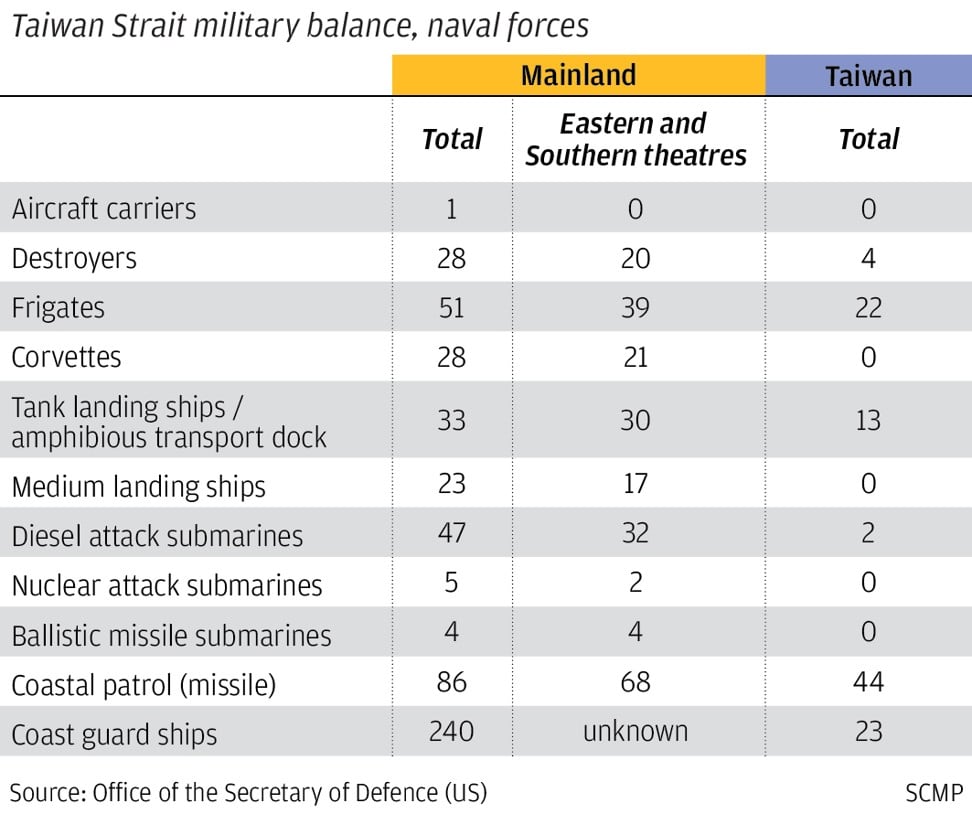
Chinese military steps up strike strength against US targets and Taiwan, says Pentagon
The improvements ‘pose major challenges to Taiwan’s security’, US Congress is told in week of new Act authorising greater US support to the self-ruling island
China’s military is better equipped for strikes against the US and the self-ruled island of Taiwan, according to a Pentagon report released on Friday.
In its annual report to the US Congress on China’s military developments, the Pentagon said the People’s Liberation Army (PLA) had undergone a sweeping overhaul, expanding the capacity of its bombers to “strike US and allied forces and military bases in the western Pacific Ocean, including [the US island territory of] Guam”.
The report also said the overhaul had improved the PLA’s ability to mount air and naval attacks on Taiwan, aiming to deter the island from pursuing independence and eroding Taiwan’s historical advantages in the Taiwan Strait.
The changes are part of Chinese President Xi Jinping’s plan to modernise the military and turn it into a world-class fighting force by 2050, backed by a US$190 billion official military budget last year.
“PLA services and support forces continue to improve training and acquire new capabilities for a Taiwan contingency,” the report said.
“China’s official defence budget has grown to roughly 15 times that of Taiwan, with much of it focused on developing the capability to unify Taiwan with the mainland by force.
“These improvements pose major challenges to Taiwan’s security.”
Although Beijing says it prefers peaceful reunification of Taiwan with the mainland, the PLA has continued to focus on developing a “credible threat of force” against the island and ways to counter potential third-party intervention from the United States, which has a mutual defence treaty with Taiwan.
The Pentagon report also outlined the military options Beijing could take against Taiwan, ranging from an air and maritime blockade, to force the island to capitulate to air strikes and missile attacks; to a full-scale amphibious invasion of Taiwan and its offshore islands.
But it said there were no signs the PLA was “significantly expanding its landing ship force”, which would be necessary for an amphibious attack on Taiwan.
While the PLA streamlined its operations in the overhaul, it also added attack submarines and naval aircraft, and created new air-assault brigades to allow for land, sea and air attack options for an invasion.
However, Chang Ching, a military specialist from the Taipei-based Society for Strategic Studies think tank, said the figures from the Pentagon document may be misleading since the force size and capacity in peacetime may not reflect those in wartime.
“Any invasion operations towards Taiwan will be executed by a task force with an order of battle and force formation very different from forces during peacetime,” Chang said.
Taiwan had also prepared for asymmetric warfare – where one side has a much greater military force than the other – but its efforts “only partially address Taiwan’s declining defensive advantages”, the report said.
“The United States contributes to peace, security and stability in the Taiwan Strait by providing defence articles and services to enable Taiwan to maintain a sufficient self-defence capability,” it said.
Beijing has never renounced the use of force to reclaim Taiwan, saying the concept of Taiwanese independence crosses its “red line”, but analysts and observers say a military conflict remains unlikely.
However, cross-strait relations under Taiwanese President Tsai Ing-wen have come to a standstill, ostensibly over her refusal to acknowledge the “1992 consensus” that there is “one China”.
In recent months, Beijing has ramped up military drills around the island, increased diplomatic pressure to limit Taiwan’s space in the international arena, and offered economic sweeteners to win support.
But the escalated coercion has not shifted domestic sentiment in Taiwan in its favour, with wariness of Beijing in part responsible for catapulting Tsai and her independence-leaning Democratic People’s Party to power in 2016.
The US maintains a “robust unofficial” relationship with the island, including over US$15 billion in announced arms sales to Taiwan since 2010.
On Monday, US President Donald Trump signed the National Defence Authorisation Act, which includes provisions to improve Taiwan’s defensive capabilities, drawing Beijing’s ire.


